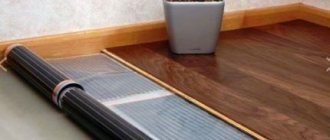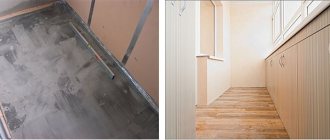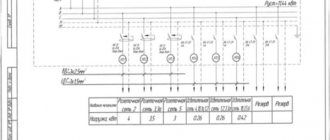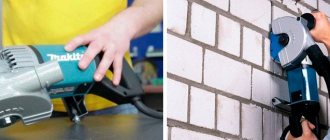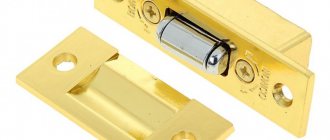In most city apartments, heating pipes have not been changed for decades. The heating network is very worn out. That is why in many private houses and apartments, even with the heating turned on at full strength, it is quite cool. The fault is the deterioration of the pipes. Many people change them even in new high-rise buildings. Changes are also made in houses.
Instructions for replacing heating pipes
Summary
Questions
1. If I refuse major repairs and replacement of heating risers, what will happen to me in the future?
1.1. You may be legally required to allow workers to perform the specified work on your premises. The courts usually satisfy the relevant claims.
1.2. Good evening. This does not threaten you with anything, since no liability is provided for by law for failure to replace risers.
2. Do I have the right to refuse to replace heating risers as part of a major overhaul?
2.1. Good evening. You do not have the right to refuse to replace heating risers, since heating risers belong to common property and their repairs are carried out at the expense of the management company or the HOA.
3. Is it necessary to pay for an emergency shutdown heating riser to replace radiators?
3.1. Hello. No, this is not provided for by law
4. Is the replacement of the common heating riser included in the current repairs?
4.1. included in major renovation
5. The heating risers in our house were replaced. According to the agreement, they must do so by August 1. We are in the Far North. The other day they installed heating in the city, but in the houses where the heating was replaced there was no heating. We called the campaign and they replied that the passports were not ready; the heating would be unknown when.
5.1. Report to the prosecutor's office IMMEDIATELY... We are talking about causing material harm and harm to the health of all residents of the houses.
6. Can the management company refuse to turn off the heating riser to replace part of the riser running inside the apartment?
6.1. Hello, I may refuse because... the riser inside the apartment belongs to the common property of the residents and is part of the heating system, alas.
7. In all apartments in the house there is a planned replacement of heating risers. There is no basement, communications are under my floor, which means they will dismantle the floor. In addition, the riser pipes are sewn into the walls, which means that the walls in my apartment will also be broken. There are no plans to restore the floor and walls after replacing the pipes. They also ask me to vacate the apartment while the pipes are being replaced, but I have nowhere to go. Is it legal to break floors and walls, damage renovations, and ask to vacate your home? And who will restore the floor, walls and repairs after replacement?
7.1. The estimate for replacing risers should include work to restore the floor and walls, under one condition - if the apartment owner did not unauthorizedly sew up the pipes into the walls and subfloor. It is illegal to demand eviction during repairs. If the walls and floor are not restored, then you can file a claim to recover the cost of restoration or be required to restore it in kind.
8. We have an emergency riser. We made an application to replace the riser and were told the welders would come in three weeks. Two days before the promised arrival, they called and postponed the replacement date for another month, due to indignation that when the heating was turned on, the riser might burst and we would flood the neighbors, they replied that they would shut off the water along the riser and then 10 apartments along the riser would be left without heating for half a month . Are there any reasonable deadlines for eliminating accidents, and what to do if these deadlines are not met?
8.1. Hello. Emergency situations must be resolved within 24 hours. Contact the Criminal Code with a written complaint or a complaint to the housing inspectorate.
9. Please tell me after what period the heating radiator risers are replaced by ZhEK.
9.1. Good afternoon Alexey, these works relate to major renovations, check with the administration when your house will undergo major renovations.
10. Can I refuse to replace heating risers if I already have new pipes? Floor 9 is the last.
10.1. If it is technically possible due to the location of the apartment on the top floor, then you can refuse to replace the heating risers.
What sets our company apart from others
There are several reasons that make people turn to us:
- extensive experience of our craftsmen - we can perform all plumbing work without exception;
- commitment - having taken on a job, we bring it to the end;
- responsibility – we are responsible for the quality of our work;
- reasonable prices - we do not inflate prices so that our services are accessible to everyone;
- efficiency – we do our work not only efficiently, but also quickly;
- politeness – our dispatchers respect their clients, they will politely and thoroughly answer all your questions asked by phone;
- preliminary agreement – you can agree with us in advance about any plumbing work in your home, our specialists will carry it out at a time convenient for you.
By choosing our company, you can be sure that all work will be completed with high quality and on time.
Reasons for replacing heating pipes
Replacement of pipes may be required for several reasons, among which two main ones can be distinguished:
- Wear and tear of the pipeline system, especially if you had metal pipes. During operation, they were exposed to moisture, which necessarily leads to corrosion and, as a consequence, destruction of the metal. In addition, over a long service life, deposits of various types form on the inner walls of the pipes, which complicates the circulation of coolant and reduces the efficiency of the heating system.
- When carrying out a major overhaul, you decide to slightly change the location of the heating devices or simply replace them with more advanced designs that are distinguished by their aesthetic properties and long service life. Or maybe you want to choose heating batteries for your apartment, which in their design will fully match the interior of the premises.
But whatever the reasons, you can in any case only carry out all the work on replacing heating pipes only in the summer, as soon as the heating season ends.
Multi-level floor
To zone the space, craftsmen install floors at different levels. They advise installing a podium to separate the kitchen and dining room. This option is considered one of the most practical because, among other things, the owners have additional free space where they can hide something.
It is convenient to use boxes or crates for this. Wicker baskets will look good. But such space can remain free.
For podiums, reliable materials are selected that can withstand heavy loads. Usually builders make wooden or metal podiums.
However, such a design should not be made if there are small children in the family, since the podium can become an obstacle for him. In addition, various floor coverings can be used.
They will zone the space between the living room and the kitchen and protect the podium from damage. For example, tiles are laid in the kitchen area, and laminate flooring in the dining room. The main thing is to choose colors and textures and combine the finishes correctly.
DIY installation
If the question of how to change the communications of the heating system is being resolved, it is necessary to take into account that the work is carried out after agreement with the management company
It is important to make sure that there is no water in the pipes. In addition, it is necessary to notify neighbors whose apartments are located above and below the riser that it is planned to replace the heating system pipeline
Tools and materials that are prepared for work:
- Bulgarian;
- welding machine (for joining metal products), soldering iron for installing polypropylene pipes;
- building level;
- connecting elements;
- shut-off valves;
- tool for cutting threads on a metal pipe;
- radiators.
Heating installation in an apartment building is carried out in stages:
communications are cut using a grinder; remove sections of the heating riser from the ceiling; first install the radiators, it is important to arrange them level to avoid air accumulation inside; communications are connected, and at the same time shut-off valves are installed at the input and output of the batteries.
At the last stage, the system is filled with water (after pressure testing). In summer there is no way to check the quality of installation. If the installation was carried out in the fall during maintenance work by employees of the management company, you will soon be able to find out how the system functions.
What to replace it with?
The following types of heating pipes are considered:
- metal: galvanized, uncoated steel, cast iron, copper;
- polymer: polypropylene, metal-plastic;
- corrugated.
In apartment buildings, steel products are often installed. However, they are more susceptible to corrosion compared to their analogues. Rust builds up inside such pipes, which leads to a decrease in the efficiency of the heating system. Galvanized products have a protective coating (inside and outside), which helps to increase their service life.
Cast iron and copper communications are practically not installed in domestic conditions. Copper is an expensive material, although it has good thermal conductivity. Cast iron products are characterized by labor-intensive installation, so they have long been replaced by modern analogues.
The most common option is to install metal-plastic pipes. Products with a metal layer inside better withstand the negative effects of high temperatures, and therefore practically do not deform during operation. Polypropylene structures containing reinforcement (a metal layer inside) are most often used when installing a heating system.
Corrugated pipes are made of metal. Steel products of this type are intended for installation in areas of complex configuration, where access is problematic and where it is not possible to install straight pipes.
When choosing, it is necessary to take into account not only the type of material from which the communications are made, but also the properties and parameters. So, the main criteria are the pipe diameter and wall thickness.
Selecting a heating pipe
heated centrally by supplying coolant to the house according to building codes and regulations
Almost all pipes that can be found on the construction market today have characteristics that can withstand even higher temperatures. The operating pressure in the heating system can vary within 3.5−5 kgf/sq.m. centimeter. But this is ideal. In reality, taking into account the human factor, it can rise to 10-12 atmospheres. If at the same time the house valves are quickly opened, then the pressure can, due to water hammer, reach the maximum critical values of 15-25 atmospheres. All these nuances must be taken into account when you buy new pipes for the heating system in your apartment.
Methods for measuring water pressure in a pipeline
Often, the pressure in the water supply in the apartment does not provide the necessary water pressure and it is difficult for a person to even wash the dishes. Household appliances also suffer from this. Standards have been developed to resolve the issue.
The apartment owner needs to follow the step-by-step algorithm:
- Study the legislation and know what the pressure should be for normal water flow.
- Protect household appliances from damage. For example, a washing machine will not be able to start working if the pressure is insufficient. Moreover, the device may break.
- Detect the time when the pressure is unstable, record the indicators on photo or video media.
- Try to identify the cause of the problem.
- Enter special measuring instruments and if the defect is poor supply, then file a complaint.
Before filing a complaint, you need to find out the reason, and there can be many of them:
- The pipeline is clogged and therefore the pipe does not allow water to flow under normal pressure.
- The pressure may jump due to a network outage or water supply level.
- The low flow is caused by a breakdown at the station.
- Stagnation in the riser.
- If one side of the pipeline is functioning and the other is not, there may be a leak or blockage somewhere.
Inspection in buildings is faster and does not require additional manipulations, because during the construction of houses, pressure gauges are initially installed. This is especially true for the private sector. To make accurate measurements, it is enough to record the indicators that the device produces throughout the day.
In old panel MKDs with a large number of floors, such devices are not provided, unless a person has made an insert for himself. If the situation has not changed during the day, then it is worth ruling out an emergency situation at the station and trying to take measurements.
Special instruments for measuring water pressure in an apartment
The stream must flow without interruption, and the pressure must comply with the approved standard. If the flow is unstable and the range of differences is regular, you should make sure that the problem is insufficient pressure.
Let's consider the main methods of this event using improvised and special instruments. There are several variations of pressure gauges: for household and industrial use. For self-measurement, the consumer can easily purchase a device that is used at home.
This device cuts into a pipe and the process is quite labor-intensive. Moreover, separate devices are installed for DHW and cold water. In modern buildings, such units are prescribed by GOST and should be in every home. A one-time measurement will not be enough. The procedure must be carried out several times every 24 hours and the readings recorded. Record data in the morning, lunchtime and evening.
Measuring water pressure without a pressure gauge
If the residential property was built a long time ago and the device was not installed during construction, there is a simpler method for performing calculations. To do this, take a jar (3 liters) and place it under running water.
While the liquid is filling the container and using a stopwatch, you need to note the time. If a three-liter jar is filled in exactly 10 seconds, then the pressure in the water supply is normal. When the indicator is less by 3-4 seconds, this indicates that the standard is exceeded, which is fraught with negative consequences.
Reasons for replacing heating pipes
People feel comfortable when they live in a warm apartment. It can be inherited, purchased on the secondary market or in a new apartment building. In any case, owners often have complaints about the current heating system and change it for the following reasons
Corroded connections may leak
Errors in circuit installation
Replacing heating pipes in an apartment is carried out in accordance with current standards and regulations. We are talking about the number and arrangement of shut-off valves and various devices (taps, pumps, etc.). In an effort to reduce the cost per square meter of housing, sometimes developers do not install the necessary elements in the required quantity. For example, when connecting radiators, shut-off valves are not installed, and in order to repair or clean such a battery, you have to close the inlet valve to the apartment and drain the water from the system.
Sometimes owners, due to inexperience, entrust heating installation to “general specialists” who undertake to do the work “quickly and cheaply”. After such “professionals”, sometimes it is necessary to completely replace risers and radiators. Even with positive hydraulic test results, there is no guarantee that unexpected problems will not arise in the near future.
Low efficiency of the heating system
It happens that even with insulated external walls and the presence of energy-saving plastic window packages, the apartment is constantly cold. The air in the rooms does not warm up, despite the fact that the temperature of the heating pipes in the apartment is high. Even if you replace the radiators, the result will not change, because the diameter of the pipes is incorrectly calculated. In this case, along with the batteries, the existing risers will have to be replaced.
Incorrect wiring diagram
- single-pipe and double-pipe;
- flow-through and dead-end,
- central and autonomous.
With any of them, horizontal wiring can be done. In this embodiment, the pipeline with the coolant is located parallel to the floor, and the heating system originates from the boiler or the main central heating riser. The pipeline passes through the rooms, after which it cuts into a riser with a return flow of coolant or returns to the heating equipment. Ultimately, it turns out to be a vicious circle.
It is better to replace old cast iron batteries during repairs
The scheme for replacing old structures should take into account how the coolant circulates, what pressure will be in the heating pipes in an apartment building, and whether the direction of water supply coincides with its return.
Increased permeability of the circuit
Heating systems face the problem of air diffusion, in which the walls of the piping slowly allow air to pass through. Penetrating into hot water, it heats up and forms air bubbles. The warmer the coolant, the more intense the process. As a result, noise appears in the collectors, which sometimes ends with water hammer. That is why building codes recommend the use of materials coated with an anti-diffusion layer with a gas permeability of no more than 100 mg/m2 per day. Ultimately, this eliminates the need to soundproof heating pipes in the apartment.
Personal preferences
Sometimes the replacement of heating elements in an apartment is explained by the personal preferences of the owners. Well, people don't like metal pipes. And the point is not in the poor characteristics of the material, but in the subjective attitude of a particular person to it. For example, he wants to focus on propylene or a product of modern technologies - PEX pipes with a modified molecular structure.
Now let’s find out how to replace pipes.
Furniture items
A few examples of furnishing a kitchen combined with a living room:
- 1. Sofa. It becomes an object that zones space. The sofa is placed with its back facing the place where food is prepared. In small rooms (less than 20 sq m) a corner is placed, which is placed against a wall installed perpendicular or parallel to the kitchen.
- 2. Set. According to designers, minimalist models without elaborate details look modern. The service, vases or glasses are placed on an open shelf. You can buy a fashionable display case for them. Furniture is placed near the wall. If the space is large (20 sq. m, 25 sq. m or 30 sq. m), then in the central part you can install an island, which also has sections for kitchen appliances.
- 3. Furniture set. The style should be combined with the design of both rooms. In small rooms, a compact table and chairs made of transparent material or painted in light colors look good. You can add a table with a round top to your living room interior. In spacious rooms, the kit is installed near the wall or in the central part. An elongated rectangular dining table would look good here.
Radiator installation
After laying a new heating riser, the radiator is installed. The installation site is marked. The radiator is applied to the wall, and the top line of the device is drawn with a pencil. The linear location is checked along the line - a building level is applied to it. After alignment, the attachment points are marked.
Holes are drilled in the walls according to the markings, dowels are inserted and fastenings - brackets - are installed. The radiator is hung on them, and its position is again checked with a building level. Checking the level is very important - if the device is installed incorrectly at a certain angle, air pockets may form. The radiator will reduce its efficiency and will be prone to dirt accumulation in the internal space.
Then the taps are screwed into the radiator, and the device is installed in its place. It is recommended to purchase and install ball valves with “American” type fittings. The squeegee is sealed with flax or thread and screwed into the radiator plug. You can read more about methods for sealing threaded connections here.
The use of squeegees facilitates the installation of the piping and allows for future replacement of batteries without disconnecting the riser. A Mayevsky valve must be installed on the radiator - a manual air vent for removing air.
Fittings are screwed into the taps and pipes are soldered to them. The riser is cut, and the radiator inlet and outlet pipes are soldered to it through the corners. A jumper is soldered between them through tees - a bypass. Sometimes a tap is installed on the bypass - when it is closed, the amount of coolant passing through the radiator increases, but the neighbors’ appliances are affected. If this faucet is discovered, minor troubles may arise with representatives of the management company.
After completing a full range of work, an application is submitted to turn on and check the tightness of the collected communications. The heating riser is filled with water with the help of representatives of the management company. Under pressure, all connections are visually inspected for leaks, drops, drips, sputum, and so on. If there are none, the work is considered completed. Any leaks that occur must be eliminated.
( , 1 today)
We recommend reading:
Infrared electric heaters
Installation and connection of gas boilers
Pipelines of water supply systems
Types of heating
Connection to cold water supply networks
How to choose the right toilet
What to do if the air cannot be displaced?
Unfortunately, an unusual situation may occur and usually working methods will be powerless. This may be due to the absence of neighbors above or the unusual design of the house, but you should always be prepared for the fact that it is not always possible to restore the heat supply to the apartment immediately. Experienced craftsmen use moving the riser to discharge, as in most cases this allows circulation to be restored. Manipulations are carried out either over plugs or over valves. To do this, you need to open the valve on one riser, and the vent on the second riser. In this case, the air will leave the battery along with the water. If there is no result, you should perform the same steps, but in the opposite direction.
It is worth noting that this technique is especially effective if aluminum or bimetallic radiators are used in the house, since they do not retain air, unlike cast iron analogues, which are prone to creating plugs, so there can be much more problems with them.
Replacing a riser in a house is not an easy task, but it is quite doable even without special knowledge. It will be very important to use high-quality materials, since otherwise even the hand of a master will not be able to protect the heating system from leaks and heat losses (pro
Replacing a heating riser - stages of work
Replacing the heating riser is carried out in a certain sequence. First of all, the old heating, sewerage and water supply risers are dismantled. For this:
- the risers are blocked, water is released from them (you need to contact the housing office);
- old pipes are cut out with a grinder, after which they are dismantled by pulling them out of the floor slabs;
- battery installation locations are marked;
- install the battery using a hammer drill and level;
- after installing the batteries, the pipes are connected;
- The bottom and top of the radiator are connected to their neighbors.
Next, replacing the heating riser will be discussed in more detail. The instructions will allow you to do the work yourself.
When does the riser need to be replaced?
Sewage scheme in an apartment made of cast iron pipes.
Conventionally, all currently existing risers can be divided into plastic and cast iron (according to the material of manufacture). In turn, cast iron risers, depending on geometric parameters, come in diameters of 73 mm and 110 mm, and plastic products - 50 mm and 100 mm. The diameter of the drain riser should match or slightly exceed the diameter of the waste pipe.
At present, as a rule, the replacement of 110 mm cast iron sewer and drain lines installed in the so-called. "Khrushchev" buildings and those that have served their useful life, onto polyvinyl chloride pipes. Please note that even relatively new pipes, depositing dust, fats and bacteria on their surfaces, if they are not cleaned at least once a year, fail.
With sufficient theoretical knowledge, the necessary tools, modern materials, devices, patience and caution, you can independently replace pipes and risers for water supply and heating. Replacing heating risers and vent risers is considered one of the most important repair operations
Replacement of risers, pipes, batteries and fan riser must be carried out in strict accordance with technology. If you have the time and money to complete the pipes, then this should be done, because... the method of “patching holes” will definitely not justify itself.
Zoning
Designers do not advise giving in to fashion trends and copying design ideas without taking into account dimensions, location and other nuances. Before planning and arranging furniture, every detail is thought through.
There are several simple rules that experts advise you to follow:
- Let the room have natural light. To do this, remove excess walls (except for load-bearing ones).
- If the rooms in the apartment are small (12 sq. m or 16 sq. m), the layout of the kitchen combined with the dining room will be the right solution.
- If the ventilation system is not designed correctly, the smell of food will spread throughout the apartment.
Preparing to replace the heating riser
Preparation for replacement consists of several stages:
- Calculation and purchase of materials;
- Submitting an application to the management company;
- Disconnecting the riser and freeing it from the coolant;
The first stage is the calculation and purchase of materials. To carry it out, you need to decide on several questions:
- Will the radiator and taps be replaced?
- Riser anchor points;
- Replacement material – pipes, fittings, etc.
If the old radiator is normal, functional, it is often not replaced. The device is washed and its operation continues.
It all depends on the desire of the owner - you can install a new radiator, characterized by more efficient operation and design. It is recommended to replace the radiator piping valves with new ones, preferably ball valves - they are less susceptible to contamination of the coolant of the centralized system.
An important issue is the anchor points of the new pipeline. The best option is to connect to the radiators of neighboring apartments located above and below. This allows you to replace sections of the riser passing through the ceiling. Steel pipes in this area are most susceptible to destruction by corrosion. Complete replacement of the riser down to the neighbors' radiators removes responsibility for the occurrence of leaks and reduces their likelihood.
But organizing such a connection is often problematic. Many neighbors are not ready to carry out work in their apartment, some have the risers covered with finishing, others simply do not want to let strangers in. There are a lot of reasons for getting rejected, both objective and far-fetched.
The main types of pipeline systems for heating repairs are polymer (plastic):
- Polypropylene;
- Metal-plastic;
- Polyethylene (cross-linked).
For laying polypropylene, open and hidden methods are used; metal-plastic and cross-linked polyethylene are laid mainly openly. This is due to the design of their fittings, which require access for seasonal maintenance. You can read about all existing types of heating pipelines here.
You can install all polymers yourself; for polypropylene you need to purchase additional equipment - a soldering iron (welding machine).
After determining the type of material, counting fittings, taps, fasteners and purchasing everything necessary, the apartment owner must contact the management company with an application to turn off the heating riser. There are different systems for accepting applications - it all depends on the management company. Some companies require written statements, while for others a phone call and verbal agreement is enough.
It is worth considering that during the heating season, management companies generally refuse to replace risers and radiators, agreeing only in emergency cases. Therefore, it is advisable to have time to carry out the planned work before the start of the heating season.
The application specifies the date and time of pipeline shutdown, the procedure for communication and notification of the start of work and its completion. When determining the date and time, neighbors are notified - those who agreed to the connection in their apartment. If there are none, there is no need to notify anyone. An agreement is reached with hired installers about the time of work if they are not carried out independently.
After organizational measures, the management company turns off the heating riser at the appropriate time, drains the water from it and notifies the owner of the apartment. You can begin installation work.
Using glue
Holes of small and medium sizes, cracks can be sealed. This option is temporary and is only suitable so as not to drain water from the riser or deprive the room of a heat source. After the heating season, the aluminum radiator must be removed in order to carry out high-quality repairs.
You can seal the hole using:
- Epoxy glue.
- Cement.
- A solution called “cold welding”.
Repairing holes with epoxy glue
To use epoxy resin glue, you need to prepare fiberglass or thick fabric. Since any of these materials must be wrapped around the radiator, the use of such adhesive is limited. After all, not every place can be wrapped easily and tightly. For some versions of aluminum radiators, this method is not suitable at all.
To seal holes or cracks:
- Cut the fabric into long narrow strips.
- Clean the area from which water is flowing. That is, remove all paint that has peeled off and all particles that are easily removed. This is done with a spatula. Next, take a brush with metal bristles and clean the surface. There should be pure metal left. It happens that a crack appears in a place where it is impossible to reach with a brush. An iron cable can help in this situation. It is pushed through the desired part of the radiator and pulled by the ends one by one, cleaning the desired area. This area is then dried.
- Apply glue to the treated area and wrap it with cloth.
- Apply glue to the fabric and wind another turn. This should be done until there are 4-5 turns. No glue is applied to the top layer of fabric.
- Secure the fiberglass using clamps or wire.
- Wait for the glue to dry. It dries from 2 hours to 3 days. If the room temperature is 20-25 °C, then it will dry in 2-3 hours.
To enhance the properties of the glue, you can add aluminum or bronze powder to it. Such powder is obtained by grinding off an unnecessary aluminum or bronze part with a rasp. Before use, the glue and powder must be mixed well.
Cracks are repaired in the same way using cement. However, medical bandages should be used instead of cloth. They need to be soaked in the solution and wound around the radiator.
We use “cold welding”
It is very convenient for sealing cracks and holes. This is a putty that looks like plasticine. There are two types:
- Single color.
- Two-color.
The first type is easier to work with, since you need to cut off the desired piece and knead it with your hands. You should wear gloves on your hands, because the putty is chemically active and can harm the skin.
Two-color cold welding must be mixed until a homogeneous solution appears. It becomes sticky while mixing.
The fight against holes using “cold welding” is carried out as follows:
- Clean the damaged area from dirt and paint.
- Knead the cut piece of “cold welding”.
- Apply the solution to the hole and rub it in (this is done with a metal spatula). To prevent the putty from remaining on the spatula, it must be moistened with water.
- If after grouting the cork begins to come out (a bubble forms, which then bursts), it must be rubbed again with a spatula. This may have to be done before the “cold weld” has completely dried. It dries in 5 minutes.
- Secure the plug with a clamp or rubber.
You can also seal the hole with heat-resistant sealant. However, you need to use the right sealant because there are acidic sealants that can corrode aluminum. Practitioners advise using neutral solutions.
Modernization of heating equipment in an apartment
Making a decision on the need to replace heating radiators, and, if necessary, pipelines, is within the competence of the owner. Mostly, such an operation is confined to general repair work, but can also be performed separately from them. To carry it out, it is necessary to carry out a number of preparatory measures and purchase new radiators.
Features of choosing heating batteries
The range of heating devices on the market is large and varied both in terms of materials used and cost characteristics. They have different design and efficiency. When choosing the required devices, parameters such as specific heat transfer and geometric dimensions should be taken into account. The first parameter, if selected correctly, will allow you to accurately maintain the temperature and humidity conditions, and the second will fit organically into the window sill niches.
When choosing heating batteries, you should take into account parameters such as specific heat transfer and geometric dimensions.
The following types of radiators are currently available for sale:
- stamped, steel panel type;
- cast iron;
- steel tubular;
- aluminum;
- bimetallic.
The last batteries on the list are the most expensive, but their efficiency is at the highest level. With rare exceptions, all modern equipment has a durable polymer or paint coating and requires annual painting. The choice of a specific type of equipment is determined by many factors, not least the financial capabilities of the client.
Preparatory activities
When replacing heating batteries with gas welding, it is necessary to perform a number of preliminary operations.
First of all, you need to dismantle the old heating devices. To do this you will need an angle grinder and cutting wheels. When cutting pipes, you need to install screens on the sides of the wall and floor, which will avoid damage to these surfaces by scale.
After separating the battery from the pipelines, it is removed from the brackets and carefully turned upside down with flanges and taken out of the room. The hanging fasteners are also dismantled, and the wall behind the radiator is cleaned and finished.
Important! In order to increase the efficiency of heaters, experts recommend installing reflective screens behind them. This will allow you to direct the infrared flux inside the room, and not to heat the wall
This will allow you to direct the infrared flow inside the room, and not to heat the wall.
Installation of new radiators
The operation of replacing heating batteries during welding should be carried out by well-trained specialists. Their qualifications must be high enough to make a sealed seam on the back side of the pipeline.
To install the battery in a niche under the window, you must first install new brackets. These items are usually supplied with the equipment or purchased separately. Markings are made in advance to ensure a strictly horizontal position of the device. It is necessary to maintain the distance from the floor recommended by the manufacturer.
A piece of pipe with a pre-cut thread is welded to the pipeline; their location must coincide with the position of the radiator flanges. The same adapters are pre-screwed into them. Next, you can perform the steps to replace heating batteries yourself. The connection is made using a coupling and a lock nut. All joints are sealed most carefully.
It is better to entrust the replacement of heating batteries with gas welding to professionals.
For this, one of two materials is used: fluoroplastic tape (FUM) or jute tow. In the second case, plumbing specialists also add a little oil paint or primer. After drying, it forms a very reliable and tight connection; in addition, this measure protects the threaded connection from corrosion. After drying, a test run of water is carried out to check the absence of leaks in all welds and joints.
Timely replacement of heating batteries will reduce the cost of heating residential and public premises directly or indirectly. In the first case, if it is possible to regulate, it is possible to reduce the supply of coolant to them or its temperature. In the second option, there will be no need to use additional devices to increase the temperature in the room.
Partitions
The interior of the kitchen and living room begins to be thought out from the junction of the two zones.
- Here are some of the ways and objects that delimit space:
- installation of a bar counter;
- kitchen island;
- big table;
- installation of a low partition.
Designers advise installing a wide counter, since you can sit at it like at a regular table, and high chairs are quite suitable for the whole family.
However, in small rooms (16 sq m), narrow counters are installed. Kitchen islands are convenient to use, but are only suitable for large kitchen-dining rooms (25 sq m or 30 sq m). Capital low partitions are installed only if it has been decided in advance what they will be used for (for example, as a TV stand).
When do you need to change pipes?
The laying of new communications is carried out in a number of cases, these are:
- blockage that has arisen due to a decrease in clearance inside, the formation of a layer of rust, limescale, while the coolant flows through the communications less intensively, which can affect their temperature, since the pressure in the heating pipes increases;
- communications are dismantled if hidden installation is planned; in this case, there may be no malfunctions in the operation of the heating system; all that is required is the transfer of pipes from the surface of vertical structures to prepared recesses;
- violation of the integrity of the pipeline, which contributed to the flooding of the premises; the cause may be an installation error or rusting of the metal;
- changing the layout of the room during renovation; in this case, communications are moved.
It is often recommended to remove old batteries along with the pipes. Metal products become unusable as a result of prolonged use.
What difficulties with the law may arise if you carry out the work yourself?
The legislation of the Russian Federation does not prohibit apartment residents from changing the risers located in their premises. However, according to Articles 44 and 46 of the Housing Code, they are considered common property, and any changes without approval are considered a violation of property rights. In practice, there will be no problems if the system operates reliably and no one has any complaints.
Everything changes when a defect is discovered on the installed pipe. Further, serious problems and punishments will appear:
- the management company will refuse to repair the system with an unauthorized change;
- If neighbors are flooded, the blame will fall entirely on the citizen who committed the unauthorized action.
The owner, represented by the management company, may demand new repairs at the expense of the tenant. For example, if you install a plastic riser without authorization, you may be required to return the metal pipe.
Galvanized and metal-plastic pipes for heating
One of the most common materials is galvanized pipe. At the same time, it must be coated with a layer of zinc not only on the outside, but also on the inside. You can verify this even by visual inspection. Why do you need to choose this particular pipe? This will give you confidence that the pipe will not rust after the first heating season, and deposits will not form on its walls.
Experienced plumbers know many examples that when such pipes were opened after several years of operation, the inside was in the same condition as after purchase. In addition, such a pipe is able to withstand all temperature and pressure changes that will occur in the heating network. The only drawback of such pipes is the labor-intensive process of processing and installation. Since from the very beginning we decided that the replacement of pipes would take place without the use of a welding machine, we would have to cut a large number of threaded connections ourselves to be able to install fittings, and during the work, carefully monitor the coincidence of the sizes of the pipes and pipes.
You can do it even simpler and install metal-plastic pipes everywhere. Such pipes are in high demand today due to their low cost, long service life, strength, and ability to withstand high temperatures and pressure. The smooth inner surface of the pipe does not give any chance for various deposits to stick to its walls. For installation you will need a special soldering iron with various attachments and all the necessary tools for such a case. Buying a device or, as it is called in a professional environment, an iron, is completely unnecessary for a one-time job; you can simply rent it for the duration of the work.
Finishing
If the kitchen combined with the living room has the same floor covering, then there are no special rules for carrying out the work. When combining different materials, take into account in advance where they will be joined.
For example, laminate flooring creates unsightly joints with tiles. The main thing is that the floor is flat without curved joints, as they will be noticeable.
Kitchen cabinets that are mounted on the walls should reach the ceilings. In some cases, craftsmen “lower” the ceiling with plasterboard.

